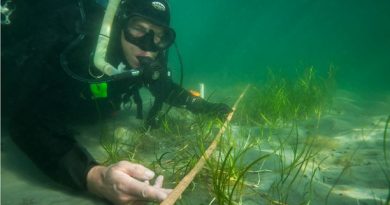Eskimo whalers seek support to build a more humane bowhead bomb
 Eskimo whalers, hoping to expand the use of a powerful new bomb that kills their giant prey quickly, have asked federal weapons regulators to permit U.S. manufacture of the explosive projectile.
Eskimo whalers, hoping to expand the use of a powerful new bomb that kills their giant prey quickly, have asked federal weapons regulators to permit U.S. manufacture of the explosive projectile.For years, the Alaska Eskimo Whaling Commission has imported limited amounts of the penthrite weapon from Norway, where it’s made for the country’s commercial minke whalers. The whaling commission has spent years working with a Norwegian expert to perfect the bomb for Alaska’s subsistence hunters. They’ve created a sophisticated weapon armed with multiple safety devices so they don’t explode before they’re embedded in the whale.
The special projectiles are said to be safer for harpooners who lean over small boats, then plunge bomb-mounted harpoons into their massive prey.
They cost about $900 each to import. They’d be cheaper and more available if made domestically, perhaps even in Fairbanks, where a machinist is working out other technical glitches related to the bombs, say whaling commission officials.
Despite the projectile’s benefits, the request before the Bureau of Alcohol, Tobacco and Firearms for U.S. production is moving slower than expected.
Officials with the bureau would not comment on the application, or even confirm if it had been submitted. Unknown is whether ATF is being cautious because penthrite, also known as PETN, has been used by terrorists to make plastic bombs.
The whaling commission’s request came six months ago, but approval has been slowed because this is unusual territory for regulators, said Jessica LeFevre, the Eskimo whaling commission attorney.
Improving whalers’ efficiency
“ATF doesn’t get a lot of requests related to the manufacture of whaling equipment these days,” she said in an email.
The harpoons and other equipment used by whalers are often generations old. Some have been passed down from the mid-19th century, when Yankee whalers came to Alaska seeking rich, new hunting grounds.
Lefevre said the bureau has no paperwork or regulations to address equipment used in the bowhead hunt. “It’s a matter of figuring out which definitions and categories apply, since the regulations are written for other kinds of equipment,” she said.
Eskimo whalers have been working since the late 1980s to replace the old black-powder bomb used for more than a century. That effort stemmed from an unfunded mandate from the International Whaling Commission to improve hunting efficiency, said Eugene Brower, longtime chairman of the Eskimo commission’s Weapons Improvement Committee.
The black-powder bombs kill whales, on average, in 62 minutes, according to a report from the 1990s. The penthrite bombs are up to four times more powerful, and cause far less bleeding. They kill a whale in about 15 minutes. If a whaler’s shot is accurate — in the neck or chest is perfect — the shock waves are so strong whales are often thought to be rendered unconscious immediately.
Over the years, the penthrite projectiles have been upgraded with multiple safety devices so they don’t explode outside the whale, endangering hunting crews. They were initially brass, but that corroded. Now, they’re titanium, becuase it’s lighter and can travel farther into the whale. Every refinement required testing. Training for the state’s 165 crews is ongoing, so captains still use the old bomb most of the time.
“We have to conform to military specifications. We have to get approval from our federal government. It’s a long process,” Brower said.
Eight of Alaska’s 11 bowhead-whaling villages are trained to use the bombs. The commission hopes to train remaining captains by year’s end, with workshops in Wales, Kivalina and Little Diomede.
Complicating the transition: Many of the most successful whaling captains prefer the black-powder bombs that have long served them well, said Johnny Aiken, executive director of the Eskimo Whaling Commission.
“There was a lot of misfires in the early days, but now we have finally come up with one that works about 90 percent of the time,” he said.
Aiken switched to the new weapon in recent years, twice landing whales. They increase the chance of landing a whale and reduce the need for repeat strikes. “It saved us a lot of black powder,” he said.
One whale died in only three minutes. “It’s worked very well,” he said.
Politics of whaling
Factors like time-to-death and lost whales are critical bargaining chips for the four countries that participate in subsistence whaling under international and federal laws. Alaska’s numbers go under the microscope this summer, when the International Whaling Commission meets in Panama in July. Eskimo whalers want to renew the annual quota they’ve had for 15 years, which would allow them to take a total of no more than 336 whales over a six-year period.
The penthrite weapons, though their use has been limited, have helped improve the percentage of bowhead whales struck that are landed. In most years, whalers exceed the commission’s annual goal of 75 percent, said Aiken.
Highlights from this spring’s whaling hunt include the village of Point Hope, where crews were recently trained to use the new penthrite bomb. They landed five whales and lost none. That’s a notable improvement from past hunts, said Herbert Kinneeveauk, head of the Point Hope whaling captains’ association, according to a report submitted to the IWC.
“Point Hope is one village where the struck-and-lost ratio has been a problem for years,” said Kinneeveauk.
Newly trained crews in Savoonga also aced their spring hunts using only penthrite bombs, killing six whales and losing none.
Deadly force
Penthrite packs a violent history. It was used for demolition during World War I. It detonated atomic bombs in World War II. More recently, terrorists such as the shoe bomber and underwear bombers have made plastic bombs with it, sometimes to deadly effect.
But it’s considered humane in the subsistence hunt because it quickly dispatches bowhead whales that can exceed 50 feet and weigh well over 50 tons.
Eskimo whalers say they’ll continue tinkering with the weapon. The commission is applying for public funds to buy barrels for the new penthrite projectiles that can cost as much as $1,000 apiece, money many whaling captains don’t have, the report said.
The commission also has recently contracted with Fairbanks machinist Jon Holmgren to create a standardized pusher shell. The shell propels the penthrite weapon deep enough into the whale so it detonates.
Currently, pusher shells are considered the “weak link” in the system.
That’s in part because whaling captains hand-prepare pusher shells, and some lack the oomph to adequately bury the penthrite grenade. They don’t seal well either, so the penthrite powder can get wet on whaling boats and malfunction.
Ideally, standardized pusher shells could be bought in a store, and be as reliable as a shotgun shell, said Holmgren.
Holmgren said he’s also been asked to work with the ATF about the possibility of manufacturing the penthrite weapons at his machine shop in Fairbanks. Whether the weapon will be made in that city is unknown, said Lefevre.
“To my knowledge the program is not far enough along for those kinds of decisions,” Lefevre said.
Contact Alex DeMarban at alex(at)alaskadispatch.com
For more stories from Alaska Dispatch, click here



